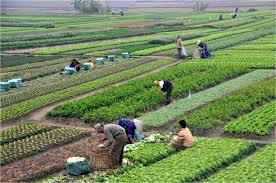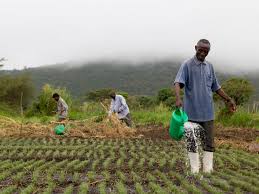Community agriculture brings people together to grow food as a team. It’s like a big garden where everyone helps and everyone benefits. Imagine your neighbors, friends, and even strangers working side by side to plant seeds, water plants, and pick fruits and vegetables. It’s not just about growing food; it’s about building a sense of togetherness and sharing.
In community agriculture, people join hands to create a shared space where they can plant and nurture crops. Everyone contributes, whether it’s time, effort, or knowledge.
It’s not only for experienced gardeners; even if you’ve never planted anything before, you can still be part of it. Together, the community learns, grows, and reaps the rewards of their collective efforts.
One of the beautiful aspects of community agriculture is the way it connects people. You might meet a neighbor you’ve never spoken to before, or you might work alongside someone from a different background. This shared experience fosters friendships and strengthens the bonds within the community. It’s not just about the crops; it’s about sowing the seeds of connection.
Picture this; a community garden where children are learning where their food comes from, families are sharing gardening tips, and seniors are passing down their years of wisdom.
Community agriculture becomes a classroom without walls, where knowledge flows naturally from one person to another. It’s a hands-on education that goes beyond textbooks and connects generations.
The benefits of community agriculture extend beyond the joy of growing and harvesting food together. It’s a sustainable way of living that reduces our carbon footprint.
When we grow our own food locally, it reduces the need for transportation, cutting down on pollution. Plus, with everyone contributing, the workload is shared, making it more sustainable for individuals as well.
There’s a unique satisfaction in eating something you’ve grown yourself, and that’s exactly what community agriculture offers. From planting the seeds to watching the plants bloom and finally harvesting the produce, every step is a shared accomplishment. The fruits of labor are not just vegetables; they are a sense of pride, accomplishment, and a shared story within the community.
Community agriculture isn’t just limited to the growing season. It extends into the entire year, with members planning and sharing resources to ensure a continuous harvest.
There’s a rhythm to the community garden, with different crops taking center stage at various times. It’s a dance of nature, where the community learns to adapt and work together in harmony with the seasons.
In the end, community agriculture is a celebration of unity. It transforms a simple plot of land into a vibrant tapestry of shared experiences and shared harvests.
It’s not just a garden; it’s a living testament to the power of collaboration. So, grab your gardening gloves, join your neighbors, and let’s cultivate togetherness through the beautiful journey of Community Agriculture.
Read Also: Poultry Products and Marketing
How to Get Involved in Community Agriculture

Getting involved in community agriculture is a rewarding journey that doesn’t require a green thumb or extensive farming knowledge. Here’s a simple guide to help you become a part of this enriching experience:
1. Locate Community Gardens: Start by finding community gardens in your area. Local community centers, online forums, or social media groups often share information about existing projects. Reach out to neighbors or friends; they might already be part of a gardening community.
2. Attend Community Meetings: Many community gardens hold regular meetings or events. Attend these gatherings to meet the members, learn about ongoing projects, and understand how you can contribute. It’s an excellent opportunity to introduce yourself and express your interest.
3. Ask Questions: Don’t hesitate to ask questions about the community garden’s goals, activities, and how they operate. Understanding their mission and structure will help you align your expectations and contributions.
4. Volunteer Your Time: Offer to volunteer your time, especially during group work sessions. Community Agriculture relies on collective efforts, and your contribution, no matter how small, makes a difference. Whether it’s planting seeds, weeding, or watering, every pair of hands helps.
5. Share Your Skills: Even if you’re not an experienced gardener, you likely have skills that can benefit the community. Maybe you’re good at organizing events, creating schedules, or managing social media. Share your skills to contribute beyond the garden.
6. Attend Workshops and Training: Many community gardens offer workshops or training sessions for members. Take advantage of these opportunities to enhance your gardening knowledge. Learning alongside others fosters a sense of community and shared growth.
7. Connect with Experienced Gardeners: If you’re new to gardening, connect with experienced members. They can provide valuable tips, guidance, and practical knowledge. Gardening is often a collaborative learning experience, and the community is there to support each other.
8. Participate in Group Projects: Community gardens often have ongoing projects, such as composting, building raised beds, or creating communal spaces. Get involved in these projects to actively contribute to the development and sustainability of the garden.
9. Contribute Resources: Offer resources that can benefit the community, whether it’s gardening tools, seeds, or other supplies. Collaboration is key, and your contributions can help the community garden thrive.
10. Be Open to Learning: Embrace the learning curve. Community agriculture is not just about growing plants; it’s about building relationships, sharing knowledge, and working together. Be open to new experiences and enjoy the process of growing alongside your community.
By following these steps, you can seamlessly integrate yourself into a Community Agriculture project and become an active participant in a shared journey of cultivation and togetherness.
Read Also: Poultry Diseases and their Prevention
The Benefits of Getting Involved in Community Agriculture

Participating in community agriculture offers a myriad of benefits that extend beyond just growing food. Here are some key advantages:
1. Community Building: Community Agriculture fosters a sense of togetherness. Working alongside neighbors and friends creates strong bonds, promotes communication, and builds a supportive community network.
2. Shared Knowledge: It’s a platform for sharing gardening tips, experiences, and knowledge. Whether you’re a seasoned gardener or a beginner, everyone brings something valuable to the table, creating a dynamic learning environment.
3. Healthy Lifestyle: Engaging in gardening activities promotes physical activity and outdoor time. It’s a wholesome way to incorporate exercise into your routine while enjoying the benefits of fresh air and sunlight.
4. Local and Sustainable Living: Growing your own food locally reduces the environmental impact of transportation. Community Agriculture promotes sustainable living by encouraging practices like composting and using organic methods.
5. Access to Fresh, Organic Produce: Community gardens provide access to fresh, organic produce that you may not find easily elsewhere. Enjoying the fruits (and vegetables) of your collective labor contributes to a healthier diet.
6. Cost Savings: By sharing resources within the community, such as tools, seeds, and knowledge, participants can save money. Community Agriculture often operates on a cooperative model, reducing individual expenses.
7. Stress Reduction: Gardening has been linked to stress reduction and improved mental well-being. The act of nurturing plants, being outdoors, and witnessing the growth of your efforts can have positive effects on mental health.
8. Educational Opportunities: Community agriculture provides an educational platform for individuals of all ages. Children can learn about where their food comes from, and adults can gain practical gardening skills through workshops and hands-on experience.
9. Beautification of the Neighborhood: Community gardens contribute to the visual appeal of neighborhoods. Transforming unused spaces into vibrant, green areas adds beauty and a sense of pride to the community.
10. Food Security: Contributing to a community garden enhances local food security. By diversifying the types of crops grown, the community becomes less reliant on external sources for food, creating a more resilient food system.
11. Cultural Exchange: Community agriculture often brings together people from diverse backgrounds. This creates opportunities for cultural exchange and understanding as members share their unique perspectives and traditions related to gardening.
12. Empowerment: Being part of a community agriculture project empowers individuals to take an active role in their food production. It instills a sense of responsibility and connection to the food they consume, promoting a more mindful approach to eating.
In essence, the benefits of community agriculture extend far beyond the garden beds. It’s about cultivating relationships, promoting sustainability, and creating a healthier, more connected community.
Read Also: TraxNYC Financing: Unlocking the World of Luxury Jewelry Acquisition

